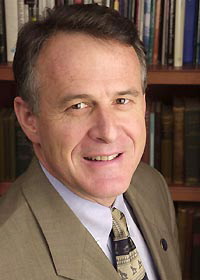|
This is an archived article.
For the latest news, go to the Advance Homepage
For more archives, go to the Advance Archive/Search Page. |
||
|
Welcome back to the start of a new academic year. This is my fourth at the University, and during my time here, there has been significant change on many fronts. The greatest and most visible of these is the physical transformation of the campus. Other significant changes which are not quite as visible have also been occurring that have a significant impact on our University in both the short- and long-term. This year we welcome an incoming class of about 3,200 students comprised of 70 percent Connecticut residents and 30 percent from out of state. Of the 18,000 applications received this year, up 4,000 from last year, the greater percentage were from out-of-state students. This is the first time in our history that the balance of in-state/out-of-state applications has shifted in this way.
This year's incoming class has an average SAT score of 1169, up a staggering 20 points from last year. To date, more than 460 valedictorians and salutatorians have joined our student body since the inception of the UConn 2000 program. On Friday, US News & World Report released its annual rankings. UConn has made a significant jump, from 31 last year to number 25 among the top public doctoral degree-granting universities in the country. And, for the first time, US News has ranked the top 100 public and private schools in the nation collectively. UConn was ranked number 64, along with Boston University and Miami University of Ohio. Other New England public universities were not even close to our position on the list, with most falling in the 90's. While we recognize that these rankings are somewhat subjective in nature, we must also accept that the vast majority of students and their parents use this information as they form their decisions about their higher education choices. The trend of high-achieving students selecting UConn as their school of choice continues and, as a by-product, we are forced to be more and more selective each year. This continued upward trend in the academic quality of our incoming students and the exposure that the building program brings to the University on a national level increases expectations of the quality of our academic programming - a challenge which we are well positioned to meet. Last week, the Board of Trustees approved a final version of our Academic Plan. A complete copy of the plan can be accessed on my website. The next step in the process is implementation. At the same time we must make decisions regarding the implementation of the academic plan, we will continue to be faced with a tenuous state budget. As of this writing, there has been no final decision regarding the "savings" which will be afforded back to the University from the early retirement program. This significantly impacts our ability to make long-term decisions about initiating new searches for both faculty and staff positions. In the short-term, a great number of retired faculty have agreed to teach courses in the fall and assist us in closing the gap between student enrollment and the high-quality teaching our students demand. Overall, the greatest challenge will be to continue to meet the academic and life needs and expectations of our students with significantly less faculty and staff, while at the same time continuing to invest wisely in building a quality UConn education. This will be a delicate balancing act that will require key players at multiple levels to make it happen. The Academic Plan will provide a framework to help us with these difficult decisions. In the coming weeks and months, I will call upon a significant number of you to assist with implementation of the Academic Plan. This needs to be a well-defined and coordinated effort to ensure success. Our best opportunity for success is a holistic approach to academic planning, and I look forward to working not only with the faculty but with key members of our support teams as well. This is sure to be an exciting year and I look forward to our continued success. |

